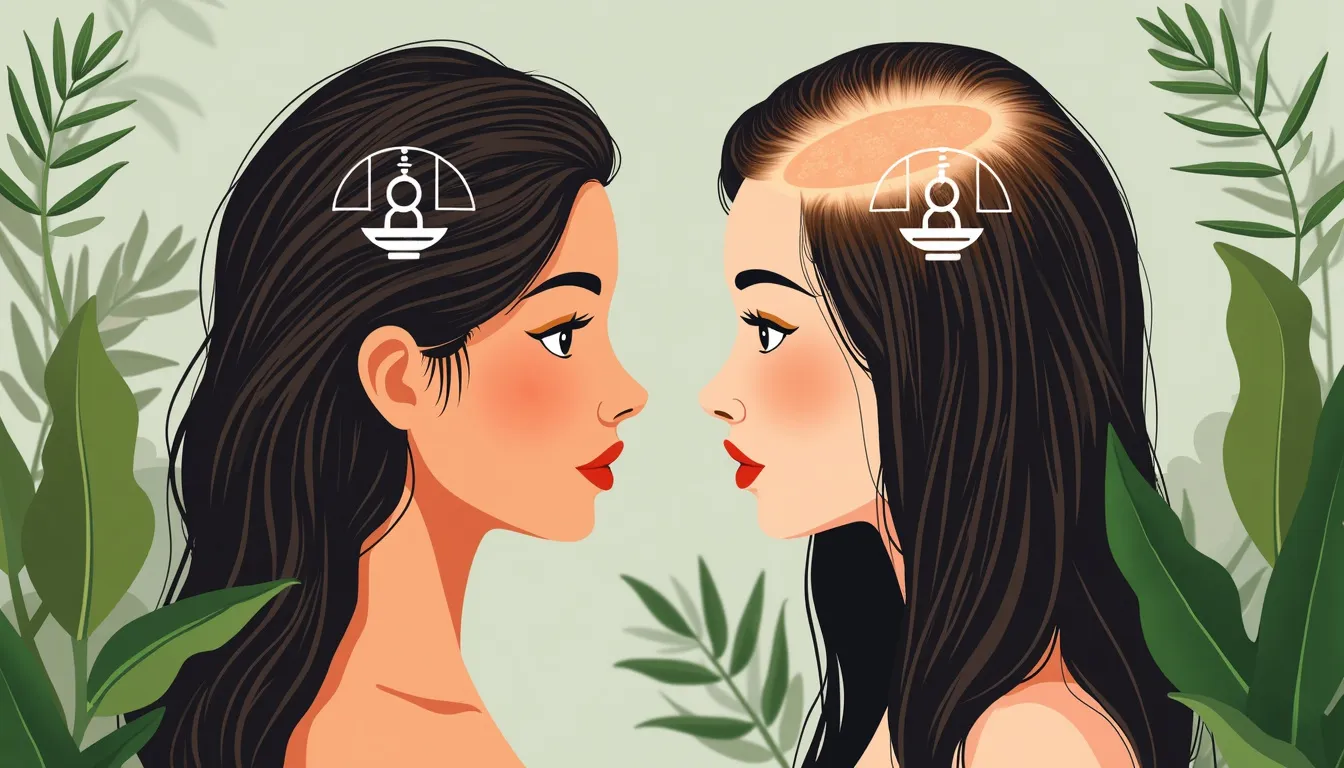Hair loss is a common concern for many, but when it comes to female pattern baldness, the emotional impact can be particularly devastating. While male pattern baldness is widely discussed and accepted, its female counterpart often remains shrouded in silence and misconception. Yet, millions of women worldwide grapple with this condition, experiencing thinning hair and visible scalp as they age. Unlike the receding hairline typical in men, female pattern baldness usually manifests as overall thinning, especially at the crown and along the part line. This gradual process can significantly affect a woman’s self-esteem, body image, and quality of life. Understanding the causes, risk factors, and available treatment options for female pattern baldness is crucial for those affected and their loved ones. In this comprehensive guide, we’ll delve into the science behind this condition, explore its various triggers, and discuss the most effective strategies for managing and treating hair loss in women. Whether you’re personally dealing with thinning hair or supporting someone who is, this article aims to provide valuable insights and practical solutions to help navigate the challenges of female pattern baldness.
Introduction to Female Pattern Baldness
Definition and Prevalence
Female pattern baldness, also known as androgenetic alopecia in women, is a common form of hair loss that affects millions of women worldwide. Unlike the more widely recognized male pattern baldness, female pattern baldness often goes unnoticed or misunderstood, leading to delayed treatment and unnecessary distress for those affected.
This condition is characterized by a gradual thinning of hair, typically starting at the crown or along the part line. Unlike men, who often experience a receding hairline, women with female pattern baldness usually maintain their frontal hairline but experience a widening part and overall decrease in hair volume.
The prevalence of female pattern baldness increases with age. Studies suggest that:
- Approximately 12% of women begin to experience noticeable hair loss by age 29
- Around 25% of women are affected by age 49
- Over 50% of women have some degree of hair loss by age 79
These statistics highlight the widespread nature of this condition, emphasizing the importance of understanding and addressing female pattern baldness.
Comparison to Male Pattern Baldness
While both female and male pattern baldness are forms of androgenetic alopecia, there are several key differences:
- Pattern of Hair Loss: Men typically experience a receding hairline and thinning at the crown, often resulting in a distinctive M shape. Women, on the other hand, usually maintain their frontal hairline but experience diffuse thinning throughout the top of the scalp.
- Progression: Male pattern baldness often progresses to complete baldness in affected areas. In contrast, female pattern baldness rarely leads to total baldness, instead resulting in overall thinning.
- Age of Onset: Men can start experiencing noticeable hair loss as early as their late teens or early twenties. For women, the onset is typically later, often becoming apparent in their 40s or 50s, though it can start earlier.
- Hormonal Factors: While both conditions are influenced by androgens (male hormones), the specific hormonal mechanisms differ. In men, dihydrotestosterone (DHT) plays a crucial role, while in women, the interplay between estrogen and androgens is more complex.
Understanding these differences is crucial for proper diagnosis and treatment, as approaches effective for male pattern baldness may not always be suitable or effective for female pattern baldness.
Impact on Women’s Self-Esteem and Quality of Life
The psychological impact of female pattern baldness should not be underestimated. Hair is often closely tied to a woman’s sense of identity, femininity, and self-image. As a result, hair loss can have profound effects on self-esteem and overall quality of life.
Studies have shown that women experiencing hair loss often report:
- Decreased self-confidence
- Feelings of embarrassment or shame
- Anxiety in social situations
- Depression and mood swings
- Reduced satisfaction with their appearance
These psychological effects can extend beyond personal life, impacting professional and social interactions. Some women report feeling less competitive in the workplace or avoiding social engagements due to their hair loss.
Moreover, the societal pressure on women to maintain a youthful appearance can exacerbate the emotional toll of female pattern baldness. Unlike men, for whom baldness is often more socially accepted, women may feel a greater stigma associated with visible hair loss.
It’s important to note that the impact of female pattern baldness can vary greatly from person to person. While some women may experience significant distress, others may be less affected. Factors such as personal coping mechanisms, support systems, and cultural attitudes towards hair loss can all influence how an individual responds to this condition.
Addressing the psychological aspects of female pattern baldness is crucial for comprehensive care. Mental health support, such as counseling or support groups, can be beneficial for many women dealing with hair loss. Additionally, education about the condition and available treatment options can empower women, helping them to feel more in control of their situation.
As we delve deeper into the causes and treatment options for female pattern baldness in the following sections, it’s essential to keep in mind the significant impact this condition can have on a woman’s well-being. By understanding both the physical and emotional aspects of female pattern baldness, we can approach treatment and support more holistically, helping women to navigate this challenging condition with confidence and resilience.
For those looking to take proactive steps in managing hair loss, consider exploring this hair loss prevention program, which offers comprehensive strategies to combat hair thinning and promote healthier hair growth.

Causes and Risk Factors of Female Pattern Baldness
Understanding the causes and risk factors associated with female pattern baldness is crucial for women experiencing hair loss. While the exact mechanisms aren’t fully understood, several factors contribute to this condition. Let’s dive into the primary culprits behind this common form of hair loss in women.
A. Genetic Predisposition
Genetics play a significant role in female pattern baldness, also known as androgenetic alopecia. If you have a family history of hair loss, you may be more susceptible to developing this condition. Here’s what you need to know about the genetic aspect:
- Inheritance patterns: Unlike male pattern baldness, which is typically inherited from the maternal side, female pattern baldness can be passed down from either parent.
- Multiple genes: Several genes are involved in hair loss, making it a complex genetic trait.
- Androgen receptor gene: Variations in this gene can increase sensitivity to androgens, potentially leading to hair loss.
While you can’t change your genetic makeup, understanding your family history can help you take proactive measures to maintain your hair health.
B. Hormonal Imbalances and Changes
Hormones play a crucial role in regulating hair growth cycles. Fluctuations or imbalances in certain hormones can contribute to female pattern baldness. Key hormonal factors include:
- Androgens: These male hormones, including testosterone and dihydrotestosterone (DHT), can shrink hair follicles and shorten the growth phase of hair.
- Estrogen: Decreases in estrogen levels, particularly during menopause, can lead to thinning hair.
- Thyroid hormones: Both hyperthyroidism and hypothyroidism can cause hair loss.
- Prolactin: Elevated levels of this hormone, often associated with pregnancy and breastfeeding, can contribute to hair loss.
Hormonal changes during pregnancy, childbirth, and menopause can also trigger temporary hair loss, known as telogen effluvium. While this type of hair loss is usually reversible, it can be distressing for many women.
C. Age-related Factors
As we age, our hair naturally undergoes changes that can contribute to thinning and loss. Age-related factors affecting female pattern baldness include:
- Decreased hair growth rate: Hair grows more slowly as we age, leading to thinner, shorter strands.
- Reduced hair density: The number of active hair follicles decreases over time.
- Changes in hair texture: Hair may become finer and more brittle with age.
- Nutritional deficiencies: Older adults may be more prone to nutritional deficiencies that can affect hair health.
While aging is inevitable, maintaining a healthy lifestyle and proper hair care routine can help mitigate some of these effects.
D. Medical Conditions and Medications
Several medical conditions and medications can contribute to or exacerbate female pattern baldness. It’s essential to be aware of these factors, especially if you’re experiencing sudden or unusual hair loss.
Medical Conditions:
- Polycystic ovary syndrome (PCOS): This hormonal disorder can lead to excess androgen production and hair loss.
- Autoimmune diseases: Conditions like alopecia areata, lupus, and thyroid disorders can cause hair loss.
- Scalp infections: Fungal infections like ringworm can cause patchy hair loss.
- Iron deficiency anemia: Low iron levels can lead to hair loss, particularly in premenopausal women.
Medications:
Certain medications can cause hair loss as a side effect. These include:
- Blood thinners (anticoagulants)
- Antidepressants
- Beta-blockers for high blood pressure
- Chemotherapy drugs
- Retinoids
- Some birth control pills
If you suspect that a medication is causing your hair loss, consult your healthcare provider before making any changes to your treatment regimen.
Understanding the causes and risk factors of female pattern baldness is the first step in addressing this common condition. While some factors, like genetics and age, are beyond our control, others can be managed through lifestyle changes and medical interventions. If you’re concerned about hair loss, it’s essential to consult with a dermatologist or trichologist who can provide a proper diagnosis and recommend appropriate treatment options.
For those looking to take proactive steps in maintaining their hair health, consider exploring hair loss prevention programs like Fortify. This comprehensive program offers personalized solutions to help combat hair loss and promote healthier, fuller hair.
Remember, female pattern baldness is a common and treatable condition. By understanding its causes and risk factors, you can take informed steps towards maintaining your hair health and boosting your confidence.

III. Treatment Options for Female Pattern Baldness
When it comes to addressing female pattern baldness, there’s no one-size-fits-all solution. However, several treatment options have shown promising results in managing this condition. Let’s explore the various approaches available to women struggling with hair loss.
A. Topical Treatments
One of the most popular and widely used treatments for female pattern baldness is minoxidil. This FDA-approved medication is available over the counter and comes in liquid or foam form.
- Minoxidil: Applied directly to the scalp, minoxidil works by increasing blood flow to the hair follicles, promoting hair growth and thickening existing hair. The 2% solution is typically recommended for women, although some may benefit from the stronger 5% formulation.
- Effectiveness: Studies have shown that minoxidil can lead to noticeable hair regrowth in about 60% of women who use it consistently for at least a year.
- Side effects: While generally well-tolerated, some users may experience scalp irritation or unwanted hair growth on the face.
It’s important to note that results from minoxidil are not permanent, and continued use is necessary to maintain any hair regrowth.
B. Oral Medications
For women who don’t respond well to topical treatments or prefer an oral option, there are several medications that can help combat female pattern baldness:
- Finasteride: While primarily used for male pattern baldness, some doctors may prescribe finasteride off-label for women. It works by blocking the conversion of testosterone to dihydrotestosterone (DHT), a hormone linked to hair loss.
- Spironolactone: This medication is an anti-androgen that can help reduce the effects of male hormones on hair follicles. It’s particularly useful for women with hormonal imbalances contributing to their hair loss.
- Birth control pills: For women whose hair loss is linked to hormonal fluctuations, certain birth control pills can help regulate hormone levels and potentially slow hair loss.
It’s crucial to consult with a healthcare provider before starting any oral medication, as these treatments can have side effects and may not be suitable for everyone.
C. Hair Restoration Techniques
For more advanced cases of female pattern baldness or when other treatments haven’t yielded satisfactory results, hair restoration techniques can offer a more permanent solution:
- Hair transplants: This surgical procedure involves moving hair follicles from areas of thicker growth to areas of thinning. While traditionally more common in men, advancements in techniques have made hair transplants a viable option for many women.
- Platelet-Rich Plasma (PRP) therapy: This innovative treatment uses the patient’s own blood platelets to stimulate hair growth. The platelets are concentrated and injected into the scalp, promoting healing and regeneration of hair follicles.
- Low-Level Laser Therapy (LLLT): This non-invasive treatment uses light energy to stimulate hair follicles. It can be administered through in-office treatments or at-home devices like laser combs or caps.
These procedures can be costly and may require multiple sessions, but they offer the potential for significant, long-lasting results.
D. Lifestyle Changes and Natural Remedies
While medical treatments can be effective, incorporating lifestyle changes and natural remedies can complement these approaches and promote overall hair health:
- Balanced diet: Ensuring adequate intake of proteins, vitamins (especially B vitamins and vitamin D), and minerals like iron and zinc can support healthy hair growth.
- Stress management: Chronic stress can exacerbate hair loss, so practices like meditation, yoga, or regular exercise can be beneficial.
- Gentle hair care: Avoiding harsh treatments, excessive heat styling, and tight hairstyles can prevent further damage to fragile hair.
- Natural oils: Some women find that massaging the scalp with oils like rosemary, peppermint, or castor oil can stimulate hair growth and improve scalp health.
- Scalp massage: Regular scalp massages can increase blood flow to hair follicles, potentially promoting hair growth.
While these natural approaches may not reverse female pattern baldness on their own, they can contribute to overall hair health and may enhance the effectiveness of medical treatments.
It’s worth noting that a comprehensive approach to treating female pattern baldness often yields the best results. Many women find success by combining multiple treatment methods under the guidance of a healthcare professional. For those looking to explore additional options, this hair loss prevention program offers a holistic approach to combating hair loss.
Remember, patience is key when treating female pattern baldness. Most treatments take several months to show noticeable results, and consistency is crucial. If you’re concerned about hair loss, don’t hesitate to consult with a dermatologist or trichologist who can provide personalized advice and treatment options tailored to your specific needs.
Female pattern baldness is a complex and often emotionally challenging condition that affects millions of women worldwide. While it may not receive as much attention as its male counterpart, the impact on a woman’s self-esteem and quality of life can be profound. Understanding the causes, risk factors, and available treatment options is crucial for those experiencing or concerned about female pattern baldness.
As we’ve explored in this article, genetic predisposition, hormonal imbalances, aging, and certain medical conditions all play significant roles in the development of female pattern baldness. While some factors are beyond our control, being aware of them can help women take proactive steps towards prevention and early intervention.
Fortunately, there are numerous treatment options available for those experiencing female pattern baldness. From topical treatments like minoxidil to oral medications such as finasteride and spironolactone, medical interventions can help slow or even reverse hair loss in many cases. For more advanced cases, hair restoration techniques like transplants and PRP therapy offer promising results. Additionally, lifestyle changes and natural remedies can complement medical treatments and contribute to overall hair health.
It’s important to remember that every woman’s experience with hair loss is unique, and what works for one may not work for another. Consulting with a dermatologist or trichologist is crucial for developing a personalized treatment plan tailored to individual needs and circumstances.
As research in this field continues to advance, we can expect even more effective treatments and solutions to emerge in the future. In the meantime, it’s essential to approach female pattern baldness with compassion, understanding, and a willingness to explore various options. By doing so, women can regain confidence and take control of their hair health journey.
For those seeking additional support and resources, programs like Fortify (available at hairsecurity.net/fortify) offer comprehensive approaches to combating hair loss. Remember, you’re not alone in this journey, and with the right information and support, it’s possible to manage female pattern baldness effectively and maintain a positive self-image.
